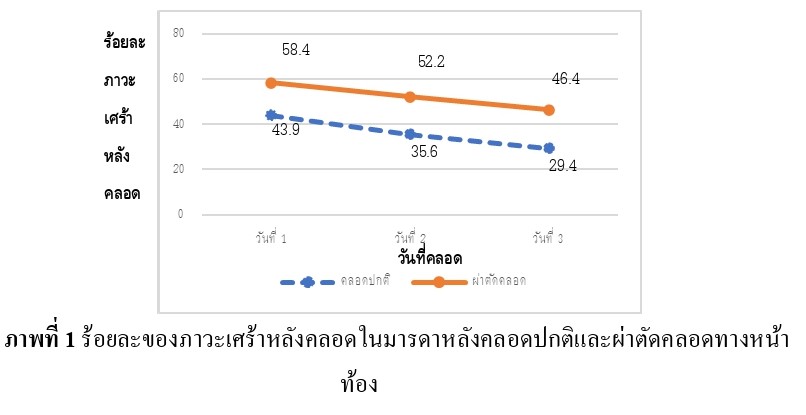ความชุกและรูปแบบของภาวะเศร้าหลังคลอดในมารดาหลังคลอดปกติ และผ่าตัดคลอดทางหน้าท้อง
รัชดา พ่วงประสงค์
คำสำคัญ:
รูปแบบภาวะเศร้าหลังคลอด, มารดาหลังคลอดปกติ, มารดาผ่าตัดคลอดทางหน้าท้องบทคัดย่อ
การวิจัยครั้งนี้เป็นการศึกษาความชุกและรูปแบบของภาวะเศร้าหลังคลอดในมารดาหลังคลอดปกติและผ่าตัดคลอดทางหน้าท้อง กลุ่มตัวอย่างเป็นมารดาที่มีภาวะเศร้าหลังคลอดในรายคลอดปกติและผ่าตัดคลอดทางหน้าท้องที่พักฟื้นหลังคลอด ณ หอผู้ป่วยสูติกรรมหลังคลอด โรงพยาบาลสมุทรปราการ จำนวน 357 ราย เครื่องมือวิจัยเป็นแบบสอบถามเกี่ยวกับข้อมูลส่วนบุคคลและอารมณ์เศร้าหลังคลอดของ Kennerley and Gath (1989) ซึ่งแปลเป็นภาษาไทยและแปลย้อนกลับ โดย Phuangprasonka et al. (2016) ที่มีค่าความเชื่อมั่นเท่ากับ 0.79 วิเคราะห์ข้อมูลส่วนบุคคลและภาวะเศร้าหลังคลอดด้วยการแจกแจงความถี่ร้อยละ ค่าพิสัย ค่าเฉลี่ยและส่วนเบี่ยงเบนมาตรฐาน ทดสอบความแตกต่างสำหรับคะแนนอารมณ์เศร้า ระหว่างกลุ่มโดยใช้ Independent t-test ผลการศึกษาพบว่า ความชุกของภาวะเศร้าหลังคลอดระหว่างวันที่ 1 - 3 หลังคลอด คิดเป็นร้อยละ 43.9 ในมารดาคลอดปกติ และคิดเป็นร้อยละ 58.4 ในมารดาผ่าตัดคลอดทางหน้าท้อง โดยพบว่า ทั้งมารดาคลอดปกติและผ่าตัดคลอดทางหน้าท้องจะมีรูปแบบของภาวะเศร้าหลังคลอดสูงสุดในวันแรกและค่อย ๆ ลดลงในวันที่ 2 และ 3 ตามลำดับ และเมื่อทดสอบความแตกต่างของคะแนนเศร้าหลังคลอดระหว่างสองกลุ่มพบว่า ระดับความรุนแรงของอาการเศร้าหลังคลอดในมารดาหลังคลอดปกติ และมารดาหลังผ่าตัดคลอดทางหน้าท้องมีความแตกต่างกันอย่างนัยสำคัญทางสถิติ (t = 4.65, p <.001)
เอกสารอ้างอิง
Ayuyen, A., Deoisres, W., & Tachasuksri, T. (2020). Prevalence and Pattern of Maternity blues in Postpartum Adolescent Mothers in Hospital. The Journal of Faculty of Nursing Burapha University, 28(4), 1 - 11. https://he02.tci-thaijo.org/index.php/Nubuu/article/view/248240
Beck, C.T., & Driscoll, J.W. (2006). Postpartum mood and anxiety disorder: A clinician guides.
Jones and Bartlett. https://www.amazon.com/Postpartum-Mood-Anxiety-Disorders-Clinici ans/dp/0763716499
Castle, J. (2009). Early detection of postpartum depression: Screening in the first two to three days. The Journal of Lancaster General
Hospital, 3(4), 147 - 150. https://www.jlgh.org/Past-Issues/Volume-3-Issue-4/Early-Detection-of-Postpartum-Depression.aspx
Corwin, E.J., Brownstead, J., Barton, N., Heckard, S., & Morin, K. (2005). The impact of fatigue on the development of postpartum depression. Journal of Obstetric, Gynecologic, & Neonatal Nursing, 34(5), 577 - 586. http://doi.org/10.1177/0884217505279997
Field, T. (2010). Postpartum depression effects on early interactions, parenting, and safety practices: a review. Infant Behavior and Development, 33(1), 1 - 6. http://doi.org/10.1016/j.infbeh.2009 .10.005
Gonidakis, F. (2012). Postpartum depression and maternity blues in immigrants. Perinatal Depression, 117 - 138. http://doi.org/10.5772/30915
Gonidakis, F., Rabavilas, A.D., Varsou, E., Kreatsas, G., & Christodoulou, G.N. (2007). Maternity blues in Athens, Greece: A study during the first 3 days after delivery. Journal of Affective Disorders, 99(1-3), 107 - 115. http://doi.org/10.1016/j.jad.2006.08.028
Hau, F.W., & Levy, V.A. (2003). The maternity blues and Hong Kong Chinese women: an exploratory study. Journal of Affective Disorders, 75(2), 197 - 203. http://doi.org/10.1016/s0165-0327(02) 00039-3
Kennerley, H., & Gath, D. (1989) Maternity blues I: Detection and measurement by questionnaire. British Journal of Psychiatry, 155, 356 - 362. https://pubmed.ncbi. nlm.nih.gov/2611547/
Krejcie, R.V., & Morgan, D.W. (1970). Determining sample size for research activities. Educational and psychological measurement, 30(3), 607 - 610. https://doi.org/10.1177/00131644 7003000308
Kurniawati, D., & Septiyono, E.A. (2022). Determinants of postpartum blues in Indonesia. Pediomaternal Nursing Journal, 8(1). http://dx.doi.org/10.20473/pmnj.v8i1.27649
Lowdermilk, D.L., Perry, S.E., Cashion, K., & Alden, K.R. (2012). Maternity & women’s health care (10th ed.). Elsevier. https://jfklib.oas.psu.ac.th/opac2/BibDetail.aspx? bibno=1151038
Manjunath, N.G., & Venkatesh, G. (2011). Postpartum blue is common in socially and economically insecure mothers. Indian Journal of Community Medicine, 36(3), 231 – 233. http://doi.org /10.4103/0970-0218.86527
O'Hara, M.W., Schlechte, J.A., Lewis, D.A., & Wright, E.J. (1991). Prospective study of postpartum blues: Biologic and psychosocial factors. Archives General Psychiatric, 48(9), 801-806. http://dx.doi.org/10.1001/archpsyc.1991.01810330025004
Phuangprasonka, R., Deoisre, W., & Chunlestskul, K. (2016). Maternity blues and management strategies of Thai postpartum women. Journal of Food Health and Bioenvironmental Science, 11(2), 23 – 27.
Pinchaleaw, D., & Serisathien, Y. (2009). Women’s distress after cesarean section. Journal of Nursing Science (Supplement), 27(2), 28 - 38.
Pinchaleaw, D., & Bhoosahas, P. (2015). Factors related to women’s distress after cesarean section. Journal of The Royal Thai Army Nurses, 16(1), 101-108. https://he01.tci-thaijo.org/index.php/JRTAN/article/view/36165
Rai, S., Pathak, A., & Sharma, I. (2015). Postpartum psychiatric disorders: Early diagnosis and management. Indian Journal of Psychiatry, 57(Suppl. 2), 216 – 221.
Rezaie-Keikhaie, K., Arbabshastan, M. E., Rafiemanesh, H., Amirshahi, M., Ostadkelayeh, S. M., & Arbabisarjou, A. (2020). Systematic review and meta-analysis of the prevalence of the maternity blues in the postpartum period. Journal of Obstetric, Gynecologic & Neonatal Nursing, 49(2), 127 - 136. https://doi.org/10.1016/j.jogn.2020.01.001
Sarah, S. B., Forozan, S. P., & Leila, D. (2017). The relationship between model of delivery and postpartum depression. Annals of Tropical Medicine & Public Health, 10(4), 874 – 877. https://www.cabidigitallibrary.org/doi/full/10.5555/20183153844
Takahashi, Y. & Tamakoshi, K. (2014). Factors associated with early postpartum maternity blues and depression tendency among Japanese mothers with full-term healthy infants. Nagoya journal of medical science, 76(1-2), 129 – 138. https://www.researchgate.net/ publication/264867289 _Factors_associated_with_early_postpartum_maternity_blues_and_depression_tendency_among_Japanese_ mothers_with_full-term_healthy_infants
Thurgood, S., Avery, D. M., & Williamson, L. (2009). Postpartum depression (PPD). American Journal of Clinical Medicine, 6(2), 17 - 22. https://www.aapsus.org/wp-content/uploads/ Postpartum-Depression.pdf
Wong, D.L., Perry, S.E., Hockenberry, M.J., & Lowdermilk, D. L., & Wilson, D. (2006). Maternal child nursing care. (3rd ed.). Mosby-Year Book.
Yokote, N. (2008). Women’s experiences of labor, surgery and first postnatal week by an emergency cesarean section. Journal of Japan Academy of Midwifery, 22(1), 37 - 48. https://www.jstage. jst.go.jp/article/jjam/22/1/22_1_37/_pdf

ดาวน์โหลด
เผยแพร่แล้ว
รูปแบบการอ้างอิง
ฉบับ
ประเภทบทความ
สัญญาอนุญาต
ลิขสิทธิ์ (c) 2024 วารสารมหาวิทยาลัยนราธิวาสราชนครินทร์

อนุญาตภายใต้เงื่อนไข Creative Commons Attribution-NonCommercial-NoDerivatives 4.0 International License.



